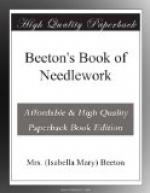[Illustration: 353.—Alphabet in Coral Stitch.]
354—– Small Alphabet.
Material: Messrs. Walter Evans and Co.’s Embroidery Cotton No. 16.
This useful alphabet is worked in satin stitch, veined in parts and ornamented with tendrils. As the alphabet of capitals (page 377, No. 351) and that of these small letters correspond, any name may be worked from them.
[Illustration: 354.—– Alphabet of Small Letters.]
355.—Alphabet (Capitals).
Materials: Messrs. Walter Evans and Co.’s Embroidery Cotton Nos. 12 and 20.
This alphabet is worked in raised satin stitch, the outlines being partly scalloped; for the fine lines, which should be worked in overcast, embroidery cotton No. 20 should be employed.
[Illustration: 355.—Alphabet in Satin Stitch.]
356. Alphabet (Capitals).
Material: Messrs. Walter Evans and Co.’s Embroidery Cotton No. 16.
The alphabet here illustrated is in the florid style; the graceful flowing lines are worked in raised satin stitch, as well as the variously-sized dots which ornament the letters.
[Illustration: 356.—Alphabet (Florid Capitals).]
357—Alphabet.
Materials: Messrs. Walter Evans and Co.’s Embroidery Cotton Nos. 12 and 16.
The letters are worked in point d’or, or dotted stitch, with an outline in fine overcast, and large raised spots in satin stitch. The ornamental wreaths round the first five letters can of course be worked round any of the others. It is very fashionable to work one letter only upon handkerchief corners.
[Illustration: 357.—Alphabet in paint d’or.]
358.—Alphabet in White Embroidery.
Material: Messrs. Walter Evans and Co.’s Embroidery Cotton No. 16
This alphabet is worked in applique; the ears of corn only are worked in overcast, satin, and knotted stitch. These letters look particularly well on transparent materials. The ears may be omitted by beginners, though they add much to the beauty of the alphabet. To this alphabet are added the ten numerals, which will be found exceedingly useful. By means of the whole alphabet and all these figures, any combination of initials and numbers can be made.
[Illustration: 358.—Alphabets and Numerals in White Embroidery.]
359.—Alphabet (see page 402).
Materials: Messrs. Walter Evans and Co.’s Embroidery Cotton No. 20; very fine black silk.
The vine-leaves and grapes of this graceful and fanciful alphabet are worked in veined and slightly raised satin stitch, the tendrils in point russe; for these the fine black silk is employed.
* * * * *
360.—Sampler (Frontispiece).
Materials: cambric muslin or fine linen; Messrs.
Walter Evans and Co.’s
Embroidery Cotton Nos. 16, 18, and 20; red cotton
and black silk.




